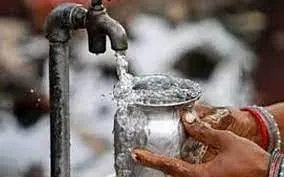Baramulla, May 5: Nestled in the Langate area of north Kashmir’s Kupwara district in the picturesque village of Humpora, Masooda begins her day at the break of dawn. A journey awaits her, one that has become an integral part of her daily routine.
Unlike most, who simply turn on the tap to get their daily dose of water, Masooda has to trek a kilometer to reach a nearby canal to fetch water for her family’s daily needs. This ordeal is further compounded by the absence of functional tap water connections at home, a daily challenge faced by the residents of Humpora village.
“The walk itself is a task, but the bigger challenge is to carry these heavy buckets of water back home. Women like me have to struggle with it because it is part of our daily routine,” says Masooda. The women of her village face the same challenge as the village does not have access to the Functional Household Tap Connections (FHTC). The nearest source of water is a canal, which is not only far away but also polluted.
Despite this, the women of the village have no choice but to rely on this source of water for their daily needs. Majority of the families here have dug up tube wells to overcome the water crises. “Fetching water from the canal has consumed my whole life. This is the only village where the government is yet to facilitate people with tap water connections,” Masooda says.
Recently, the Jal Jeevan Mission (JJM), Government of India, said that J&K was providing clean tap water to over 11.23 lakh rural households out of a total of 18.67 lakh under the JJM. According to official data, the J&K government has achieved a target of covering around 60 percent rural households under the JJM with a facility of FHTC within premises.
The survey conducted by the GoI revealed that around 5.47 lakh rural households had been covered with FHTC under the JJM by the J&K government. With this, the number of rural households with functional tap water connections has increased from 5.75 lakh in 2019 to 11.23 lakh (60.13 percent)
But Masooda’s family is one such family among the left out five lakh households, which have been deprived of functional tap water connection. “The water we fetch from the canal is not always clean or safe to drink, which puts the family’s health at risk,” she said.
The lack of access to clean water is not just a problem for Masooda alone but for many other rural communities across Kashmir where women folk have to fetch the drinking water from a nearby source. Access to functional tap water within premises is a basic necessity but for thousands of people living in rural areas the lack of access to clean water remains a major challenge. Like Humpora, many such villages in parts of north Kashmir are sailing in the same boat. “It is not only physically demanding but also time-consuming. Fetching water from a far away source on a daily basis is cumbersome and leaves most of the women of this area little time to attend to their other responsibilities,” says Nighat. “In many cases, we have to make multiple trips a day, which adds to our workload and puts us at risk of physical injuries.”
Talking to Greater Kashmir Mission Director JJM J&K, G N Itoo says they were hopeful to cover all the left out rural households with functional tap water connection in J&K under JJM as per the set guidelines. “Under JJM we follow a cluster level approach wherein a minimum of 20 rural uncovered households are covered with functional tap water connection under JJM,” Itoo says. About the problems faced by people of Humpora and Mirgund, Itoo says they have identified some chronic areas, which were being covered on priority under the JJM.
“For Mirgund and other areas like Parihaspora, the government had taken some initiative earlier but the scheme faced some funding issues. Now these areas and some other areas of Pattan are being covered on priority under two schemes of JJM,” he says. “I am hopeful that all the households will have tap water connections by the end of this year.”







